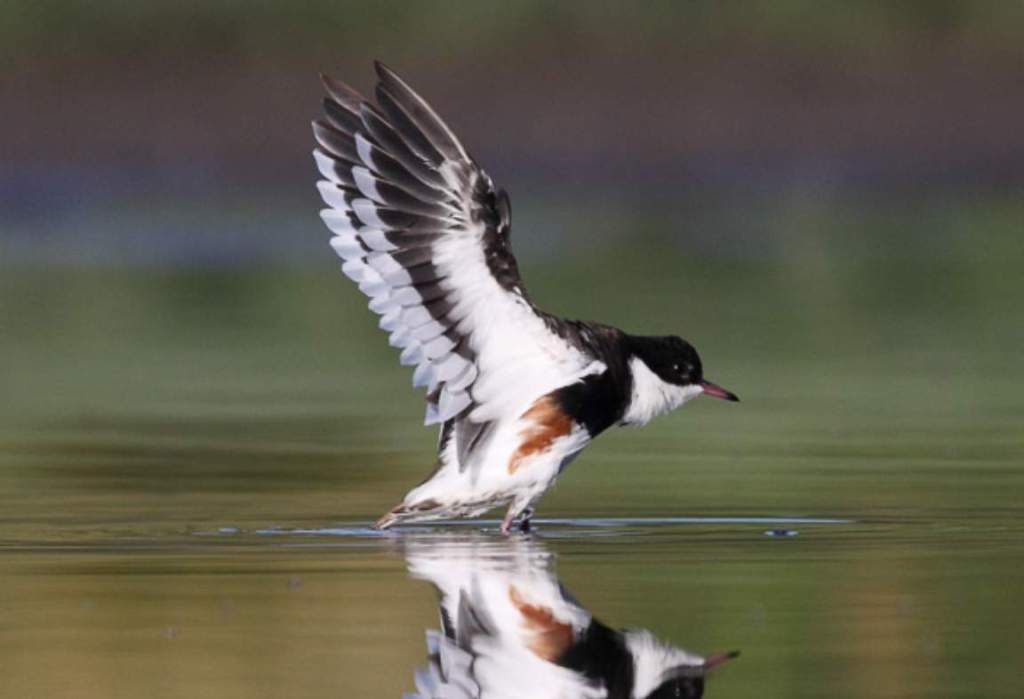Habitats: The Red-kneed Dotterels (Erythrogonys cinctus) live on the inundated muds of temporary flood lands inland. They are nomadic, loosely gregarious, and aquatic waders. Usually found in loose group of up to 40 to 50 birds, they follow shallow floodwaters and feed primarily in shallow water, probing, even submerging their heads in mud while swimming adeptly. Despite their small size, chicks are capable of swimming. Breeding territories are small, and nesting pairs tolerate each other nearby. Both sexes may engage in fighting after threat posturing with flattened crowns and raised napes.
It is common for courting males to tilt their bodies forward, fluff their feathers, and trill from the nest site. The female may stop in a chase, body horizontal, and wings partly spread, and allow the male to mate. A variety of distraction displays are used by both adults to protect the nest, including rodent-runs, flutter jumps, and false-brooding displays. In addition to having a hind toe, no salt-secreting glands, and boldly marked precocial chicks, Red-kneed Dotterels are unusual among plovers.

Identification: Both sexes are similar. The crown, nape, and sides of the face are black, rest of the upper parts olive-brown. Flight feathers black with broad white trailing edge. Broad is a black band across the breast; the rest of the underparts are white; flanks chestnut, edged white. The tail is white, with a dusky center stripe. The eyes are dark brown. The bill is pink with a black tip. The feet are deep grey, with pink around the ‘knee’ and tibia. The immature bird is plain mid-brown above, white below with a faint brown breast band; the bill and feet are dull. The downy young are grey above mottled gold and black, with a white crescent around the hind head; white below.
Vocalizations: The Red-kneed Dotterel makes a Staccato chet-chet call in contact and flight. Soft trilling in threat display.
Diet: Invertebrates like beetles and other invertebrates are picked up by dotterels due to their long legs. If alarmed, they bob their heads and even their bodies before flushing off low and weaving quickly. The food mainly consists of arthropods, molluscs, annelids, and seeds.
Nest & Breeds: Moreover, nesting and breeding usually take place between September-December and any month depending on the rain. Nest in a small depression in the ground, near the edge of a swamp or lake, often sheltered by low shrubs; lined with dry herbage.
Size: The Red-kneed Dotterel measures about 170-180 mm long, has a wingspan of 13–15 inches, and a weight of 45–55 grams.
Eggs: Red-kneed Dotterel lays two to four eggs; dull ochre-yellow, speckled with dark brown and black hair-like markings and blotches; pyriform, about 30 x 22 mm. Both sexes incubate.
Distribution: The red-kneed dotterel is native to mainland Australia, Papua New Guinea, and Indonesia, and has occurred as a vagrant in Tasmania, Palau, and New Zealand. In Australia, it is found throughout inland and shallow swamps and flood sheets with vegetation. Also, coastal areas are rare in the East. Nomadic.

Family: The red-kneed dotterel is a plover species in a monotypic genus in the subfamily Vanellinae.
Races: No races.
Kingdom: Animalia
Order: Charadriiformes
Binomial name: Erythrogonys cinctus
Domain: Eukaryota
Class: Aves
Phylum: Chordata
Genus: Erythrogonys
Species: E. cinctus
Read More – The Versatile Little Ringed Plovers







